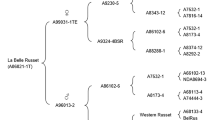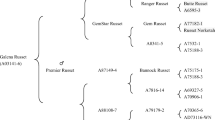Abstract
Teton Russet is an early-maturing, medium-russeted, potato cultivar with high merit for both fresh-pack and processing. In early harvest trials in the Pacific Northwest, Teton Russet had total yields similar to Russet Norkotah, and higher than Ranger Russet and Russet Burbank. Marketable yield of Teton Russet in the early harvest trials was also comparable to or higher than Russet Norkotah in Washington and Oregon, and higher than Ranger Russet and Russet Burbank at these sites, as well as in Idaho. In full-season trials, while total yield of the earlier-maturing Teton Russet tended to be lower than Ranger Russet and Russet Burbank, marketable yield was generally higher than Russet Burbank across the majority of sites due to its higher percentage of U.S. No. 1 tubers. Teton Russet is suitable for processing, with acceptable fry color following up to 8 months of storage at 8.9 °C. Uniformity of fry color was also very consistent. Teton Russet has shown lower levels of the amino acid asparagine relative to Ranger Russet and Russet Burbank which may contribute to lower acrylamide levels in French fries and other processed potato products. Teton Russet is notable for having resistance to common scab (Streptomyces spp.) and Fusarium dry rot, and is moderately resistant to tuber net necrosis. Analyses have also shown Teton Russet to have significantly higher protein levels than Russet Norkotah, Ranger Russet, and Russet Burbank, as well as higher vitamin C content than Russet Norkotah and Russet Burbank. Teton Russet was released in 2011 by the USDA-ARS and the Agricultural Experiment Stations of Idaho, Oregon, and Washington, and is a product of the Pacific Northwest Potato Variety (Tri-State) Development Program.
Resumen
Teton Russet es una variedad temprana de papa, de piel medianamente rugosa, con amplios méritos tanto para mercado fresco como para proceso. En ensayos de cosecha temprana en el noroeste del pacífico Teton Russet tuvo rendimientos similares a Russet Norkotah, y mayores que Ranger Russet y Russet Burbank. El rendimiento comercial de Teton Russet en estos ensayos de cosecha temprana también fueron comparables o mayores a Russet Norkotah en Washington y Oregon, y mayores que Ranger Russet y Russet Burbank en estos sitios, así como en Idaho. En los ensayos de ciclo completo, mientras que el rendimiento total de la variedad temprana Teton Russet tendió a ser más bajo que Ranger Russet y Russet Burbank, el rendimiento comercial fue generalmente mayor al de Russet Burbank en la mayoría de los sitios, debido a su porcentaje más alto de tubérculos US1. Teton Russet es deseable para proceso, con color de freído aceptable después de ocho meses de almacenamiento a 8.9 º C. La uniformidad en el color del freído también fue muy consistente. Teton Russet ha mostrado niveles más bajos del aminoácido asparagina en relación a Ranger Russet y Russet Burbank, lo que pudiera contribuir a niveles inferiores de acrilamida en papas a la francesa y otros productos procesados de la papa. Teton Russet es notable por su resistencia a la roña común (Streptomyces spp.) y a la pudrición seca por Fusarium, y es moderadamente resistente a la necrosis del tubérculo. Los análisis también han demostrado que Teton Russet tiene significativamente mayores niveles de proteína que Russet Norkotah, Ranger Russet y Russet Burbank, así como contenido más alto de vitamina C que Russet Norkotah y Russet Burbank. Teton Russet se liberó en 2011 por USDA-ARS y por las estaciones agrícolas experimentales de Idaho, Oregon y Washington, y es un producto del Programa de Desarrollo de Variedades de Papa Triestatal del Pacífico Noroeste.



Similar content being viewed by others
References
Akeley, R.V., F.J. Stevenson, and E.S. Schultz. 1948. Kennebec: A new potato variety resistant to late blight, mild mosaic, and net necrosis. American Potato Journal 25: 351–361.
Bergers, W.W. 1980. A rapid quantitative assay for solanidine glycoalkaloids in potatoes and industrial potato protein. Potato Research 23: 105–110.
Bradford, N.M. 1976. A rapid and sensitive method for the quantitation of microgram quantities of protein using the principle of protein dye binding. Analytical Biochemistry 72: 248–254.
Brown, C.R., H. Mojtahedi, G.S. Santo, P. Hamm, J.J. Pavek, D. Corsini, S. Love, J.M. Crosslin, and P.E. Thomas. 2000. Potato germplasm resistant to corky ringspot disease. American Journal of Potato Research 77: 23–27.
Brown, C.R., H. Mojtahedi, S. James, R.G. Novy, and S. Love. 2006. Development and evaluation of potato breeding lines with introgressed resistance to Columbia root-knot nematode (Meloidogyne chitwoodi). American Journal of Potato Research 83: 1–8.
Corsini, D., and J.J. Pavek. 1986. Fusarium dry–rot resistant potato germplasm. American Potato Journal 63: 629–638.
Corsini, D.L., J.J. Pavek, and J.R. Davis. 1988. Verticillium wilt resistance in non-cultivated tuber-bearing Solanum species. Plant Disease 75: 148–151.
Corsini, D.L., J.J. Pavek, M.W. Martin, and C.R. Brown. 1994. Potato germplasm with combined resistance to leafroll virus and viruses X and Y. American Potato Journal 71: 377–385.
Dees, M.W., and L.A. Wanner. 2012. In search of better management of potato common scab. Potato Research 55: 249–268.
Halford, N.G., N. Muttucumaru, S.J. Powers, P.N. Gillatt, L. Hartley, J.S. Elmore, and D.S. Mottram. 2012. Concentration of free amino acids and sugars in nine potato varieties: Effect of storage and releationship with acrylamide formation. Journal of Agricultural and Food Chemistry 60: 12044–12055.
Haynes, K.G., B.J. Christ, D.P. Weingartner, D.S. Douches, C.A. Thill, G. Secor, W.E. Fry, and D.H. Lambert. 2002. Foliar resistance to late blight in potato clones evaluated in national trials in 1997. American Journal of Potato Research 79: 451–457.
Haynes, K.G., L.A. Wanner, C.A. Thill, J.M. Bradeen, J. Miller, R.G. Novy, J.L. Whitworth, D.L. Corsini, and B.T. Vinyard. 2010. Common scab trials of potato varieties and advanced selections at three U.S. locations. American Journal of Potato Research 87: 261–276.
Hoyman, W.G., and R.C. Holland. 1974. Nooksack: A russet potato adapted to northwestern Washington. American Potato Journal 51: 99–102.
Johansen, R.H., B. Farnsworth, D.C. Nelson, G.A. Secor, N. Gudmestad, P.H. Orr, and A.A. Boe. 1986. NorKing Russet: A new russet-skinned potato cultivar. American Potato Journal 63: 701–707.
Knowles, N.R. and M.J. Pavek. 2013. WSU potato cultivar yield and postharvest quality evaluations for 2012. Washington State University Special Report. pp. 18-19. Accessed August 13, 2013 at http://potatoes.wsu.edu/trials/
Love, S.L., T. Salaiz, B. Shafii, W.J. Price, A.R. Mosley, and R.E. Thornton. 2004. Stability of expression and concentration of ascorbic acid in North American potato germplasm HortScience 39: 156–160.
Love, S.L., R. Novy, J. Whitworth, D.L. Corsini, J.J. Pavek, A.R. Mosley, R.E. Thornton, N.R. Knowles, S.R. James, and D.C. Hane. 2005. Summit Russet: A new russet potato variety with good fresh market and frozen processing qualities. American Journal of Potato Research 82: 425–432.
Mosley A, S. Yilma, D. Hane, S. James, K. Rykbost, C. Shock, B. Charlton, E. Eldredge, and L. Leroux. 2003. Oregon. In: K.G. Haynes (ed), National Potato Germplasm Evaluation and Enhancement Report, 2001. pp. 369-388.
Nitzan, N., M.A. Evans, T.F. Cummings, D.A. Johnson, D.L. Batchelor, C. Olsen, K.G. Haynes, and C.R. Brown. 2009. Field resistance to potato stem colonization by the black dot pathogen Colletotrichum coccodes. Plant Disease 93: 1116–1122.
Novy, R.G., J.L. Whitworth, J.C. Stark, B.A. Charlton, S. Yilma, N.R. Knowles, M.J. Pavek, T.L. Brandt, S. Gupta, N. Olsen, M. Thornton, C.R. Brown, D.L. Corsini, J.J. Pavek, S.R. James, D.C. Hane, H. Lozoya-Saldana, and M.I. Vales. 2012. Palisade Russet: A Late Blight Resistant Potato Cultivar Having a Low Incidence of Sugar Ends and High Specific Gravity. American Journal of Potato Research 89: 89–101.
Pavek, J.J., D.L. Corsini, D.R. Douglas, R.E. Ohms, J.G. Garner, H.C. McKay, C. Stanger, G.E. Vogt, W.C. Sparks, R. Kunkel, J.R. Davis, A.J. Walz, C.E. Dallimore, and J. Augustin. 1978. Butte: A long russet potato variety with excellent dehydrating quality. American Potato Journal 55: 685–690.
Ross F.A. 1959. Dinitrophenol method for reducing sugars. In: W.F. Talburt and O. Smith, (eds.), Potato Processing, AVI Publ., Westport, Connecticut pp. 469-470.
Stark, J.C., R.G. Novy, S.L. Love, J.L. Whitworth, D.L. Corsini, J.J. Pavek, A.R. Mosley, M.J. Pavek, N.R. Knowles, R.E. Thornton, S.R. James, D.C. Hane, N. Olsen, and M.I. Vales. 2007. Blazer Russet: An early to mid-season potato cultivar with high U.S. No. 1 yields and good processing and culinary qualities. American Journal of Potato Research 84: 467–477.
Stark, J.C., R.G. Novy, J.L. Whitworth, N.R. Knowles, M.J. Pavek, S.L. Love, M.I. Vales, S.R. James, D.C. Hane, C.R. Brown, B.A. Charlton, D.L. Corsini, J.J. Pavek, N. Olsen, and T. Brandt. 2010. Classic Russet: A potato cultivar with excellent fresh market characteristics and high yields of U.S. No. 1 tubers suitable for early harvest or full-season production. American Journal of Potato Research 87: 360–373.
United States Standards for Grades of Potatoes. 1997. United States Department of Agriculture, Agricultural Marketing Service. p 2.
Acknowledgments
The authors thank Margaret Bain, William Buhrig, Mel Chapel, Todd Carter, Mary Jo Frazier, Nora Fuller, Darren Hall, Mark Fristad, Teri Hill, Zach Holden, Chelsey Lowder, Charlene Miller, Bart Nelson, Brian Schneider, Lura Schroeder, Penny Tubbs, Rich Quick, Steve Wheeler, and Jim Whitmore for their contributions to the development and release of Teton Russet, as well as Shelley Jansky for her review and suggestions for improvement of the manuscript prior to submission for publication. We also thank Lori Ewing, University of Idaho, for her efforts in establishing pathogen-free in vitro plantlets of Teton Russet, as well as our industry cooperators, our collaborators in the Western Regional Potato Variety Trials, and the Idaho, Washington, and Oregon potato commissions. Development of Teton Russet was partially funded by the USDA/CSREES Special Potato Program Grant.
Author information
Authors and Affiliations
Corresponding author
Additional information
S.R. James and D.C. Hane are retired from Oregon State University.
Rights and permissions
About this article
Cite this article
Novy, R.G., Whitworth, J.L., Stark, J.C. et al. Teton Russet: An Early-Maturing, Dual-Purpose Potato Cultivar Having Higher Protein and Vitamin C Content, Low Asparagine, and Resistances to Common Scab and Fusarium Dry Rot. Am. J. Potato Res. 91, 380–393 (2014). https://doi.org/10.1007/s12230-013-9362-8
Published:
Issue Date:
DOI: https://doi.org/10.1007/s12230-013-9362-8




